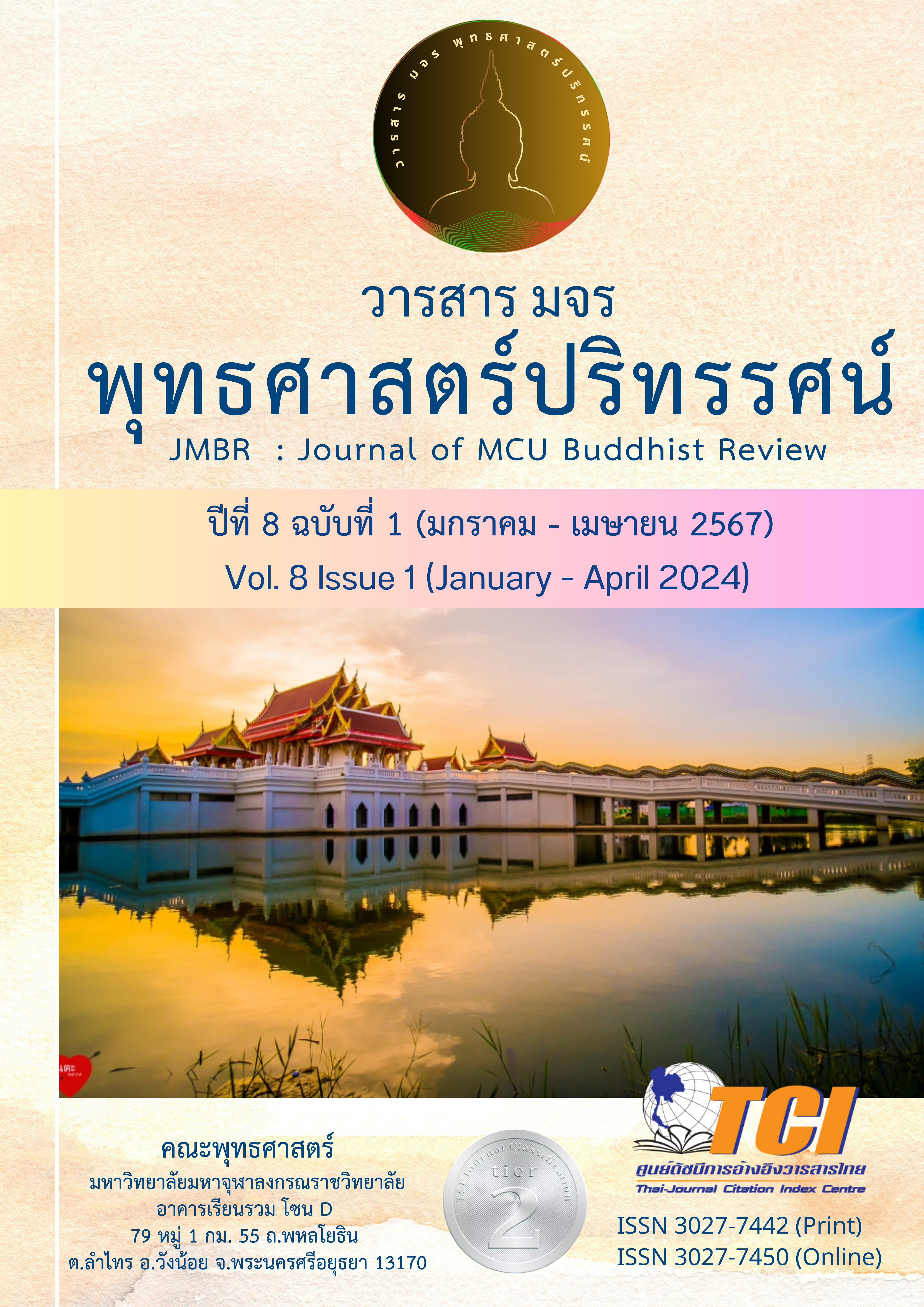ดนตรี: สุนทรียศาสตร์สู่การบรรลุธรรม
Main Article Content
บทคัดย่อ
บทความวิชาการว่าด้วย สุนทรียศาสตร์ ศาสตร์ว่าด้วยความงาม การรับรู้ในความงามนั้นเป็นความสามารถที่มีอยู่ในมนุษย์ทุกคนตามธรรมชาติผ่านประสาทสัมผัสทั้งห้า ไม่ว่าจะเป็นการมองเห็น การได้ยิน การได้กลิ่น การลิ้มรส และการสัมผัส ในบางครั้งความงามสามารถมีผลในการยกใจมนุษย์ให้สูงขึ้นได้ กล่าวได้ว่าสุนทรียศาสตร์และศิลปะเป็นสิ่งเดียวกัน ดนตรีเองก็เป็นศิลปะที่ต้องใช้ประสบการณ์ทางสุนทรียศาสตร์เป็นพื้นฐาน สุนทรียศาสตร์มีบทบาทสำคัญในศาสนามาช้านาน โดยเฉพาะในศาสนาพุทธ พระไตรปิฎกมีตัวอย่างมากมายที่แสดงให้เห็นถึงการใช้สุนทรียศาสตร์ในการสอนธรรมะ ซึ่งความเข้าใจของคนทั่วไปมักจะรู้สึกว่าดนตรีเป็นสิ่งที่รบกวนการปฏิบัติธรรม รวมถึงการที่พระพุทธเจ้าได้ทรงบัญญัติวินัย สิกขาบท และโทษสำหรับนักบวชว่าไม่ให้ขับร้องเพลง แต่หากพิจารณาดูให้ดี พระพุทธองค์ก็ได้ทรงอนุญาตให้สามารถสวดเป็นทำนองสรภัญญะได้เช่นกัน ซึ่งหมายความว่าหากเนื้อหาในบทเพลงเป็นธรรมะ และทำนองเพลงทำให้เกิดความสงบและสมาธิ กล่อมเกลาจิตใจให้อ่อนโยนลงได้แล้ว บทสวดนั้นก็สามารถเป็นหนึ่งในข้อวัตรปฏิบัติของนักบวชที่จะเพียรภาวนาเพื่อสร้างเหตุแห่งการบรรลุธรรมให้เกิดขึ้นได้ ยิ่งไปกว่านั้นดนตรีหรือเพลงธรรมะที่ปรากฏอยู่ในพระไตรปิฎกและอรรถกถาแสดงให้เห็นถึงปรากฏการณ์การบรรลุธรรมและการที่ธรรมะเข้าสู่จิตใจได้โดยผ่านบทเพลง
Article Details

อนุญาตภายใต้เงื่อนไข Creative Commons Attribution-NonCommercial-NoDerivatives 4.0 International License.
- บทความที่ได้รับการตีพิมพ์เป็นลิขสิทธิ์ของวารสาร มจร พุทธศาสตร์ปริทรรศน์
- ข้อความใดๆ ที่ปรากฎในบทความที่ได้รับการตีพิมพ์ในวารสาร ถือเป็นความรับผิดชอบของผู้เขียนบทความ และข้อคิดเห็นนั้นไม่ถือว่าเป็นทัศนะและความรับผิดชอบของกองบรรณาธิการวารสาร มจร พุทธศาสตร์ปริทรรศน์
เอกสารอ้างอิง
คณะกรรมการแผนกตำรา มหามกุฏราชวิทยาลัย ในพระบรมราชูปถัมป์. (2549). มังคลัตถทีปนีแปล เล่ม 3. กรุงเทพฯ: มหามกุฏราชวิทยาลัย.
พระมหาธิติพงศ์ อุตฺตมปญฺโญ. (2563). มังคลัตถทีปนีแปล ภาค 1 เล่ม 2. กรุงเทพฯ: บริษัท สหมิตรพัฒนาการพิมพ์ จำกัด.
พระมหาสาคร ศรีดี. (2545). วิเคราะห์หลักพุทธจริยธรรมที่ปรากฏในเพลงพื้นบ้านจังหวัดสุพรรณบุรี: ศึกษาเฉพาะกรณีเพลงอีแซว. วิทยานิพนธ์ศิลปศาสตรมหาบัณฑิต บัณฑิตวิทยาลัย: มหาวิทยาลัยมหิดล.
พระศรีนรินทร ธนปาโล (มโนกุล). (2561). วิเคราะห์หลักพุทธธรรมที่ปรากฏในบทเพลงของจรัล มโนเพ็ชร. วิทยานิพนธ์พุทธศาสตรมหาบัณฑิต บัณฑิตวิทยาลัย: มหาวิทยาลัยมหาจุฬาลงกรณราชวิทยาลัย.
พระสิริมังคลาจารย์. (2498). มงฺคลตฺถทีปนี ปฐโม ภาโค. กรุงเทพฯ: มหามกุฏราชวิทยาลัย.
มหาจุฬาลงกรณราชวิทยาลัย. (2539). พระไตรปิฎกภาษาไทย ฉบับมหาจุฬาลงกรณราชวิทยาลัย. กรุงเทพฯ: มหาจุฬาลงกรณราชวิทยาลัย.
มหามกุฏราชวิทยาลัย. (2470). พระไตรปิฎกภาษาบาลี ฉบับสยามรัฐ. กรุงเทพฯ: โรงพิมพ์พาณิชศุภผล ถนนสามเพ็ง.
อานนท์ กาญจนโพธิ์. (2564). ศาสนาสุนทรียศาสตร์วิจารณ์. วารสารวิพิธพัฒนศิลป์ บัณฑิตศึกษา. 1(2), 64-80.
Phra Woraponte Tanpoonkiat. (2023). Music Intervention Therapy to Improve Healthy Mind. Journal of MCU Buddhism Review. 7(2), 25-34.


